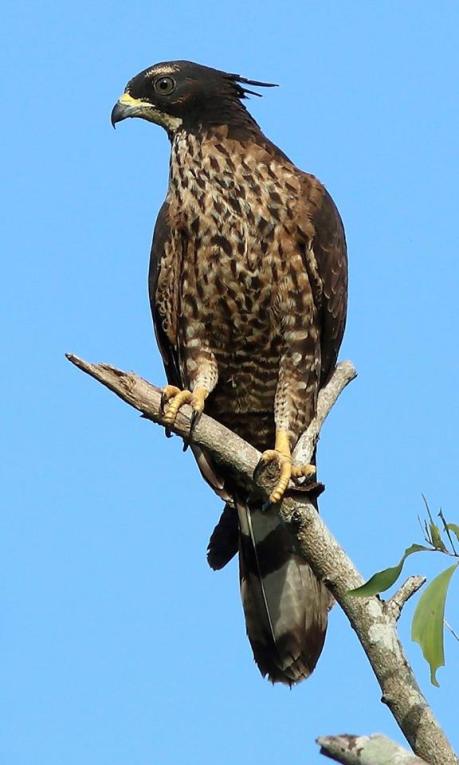Juvenile Oriental Honey Buzzard (orientalis) at Pasir Ris Park that prompted this blog. Photo: Seng Alvin.
Seng Alvin posted a photo of a juvenile Oriental Honey Buzzard on Bird Sightings FB page recently. After some discussion he asked “Can tell me the specific species of OHB?. What he wanted to know is if there a difference between a Crested Honey Buzzard and an Oriental Honey Buzzard? What is a resident torquatus race? We will try to answer these questions in this blog.
A maturing adult Oriental Honey Buzzard (orientalis), the most common sub species that passed through Singapore during the winter months. Photo: Seng Alvin.
For simplicity, let’s consider that the genus “Pernis” broadly consists of Western Honey Buzzard (P. apivorus), Eastern Honey Buzzard (P. ptilorhynchus) and Barred Honey Buzzard (P. celebensis) belonging to the endemic races in The Philippines and Indonesia.
The Western Honey Buzzard is a summer migrant to Europe and West Asia, and it winters in Africa.
Due to the biodiversity in the Asia Continent, the Eastern Honey Buzzard has evolved into two groups. The migratory orientalis may be referred to as Oriental Honey Buzzard and the sedentary ptilorhynchus broadly classed under Indomalayan or Crested Honey Buzzard. (Note that most guidebooks treat them as one species, often using the name Oriental Honey Buzzard).
A typical migratory dark morph adult male Oriental Honey Buzzard (orientalis).
The migratory Oriental Honey Buzzard, orientalis, breeds across Eurasia, Central Siberia, Northern Japan, Korea and North East China. They migrate to continental South East Asia, Indonesia and The Philippines during the winter months. This is the most common subspecies of Honey Buzzard that passes through Singapore from September with the adults arriving early followed by juveniles in October. Some, mostly juveniles may winter here. In March, a smaller number can be observed passing through on their Spring migration back North.
There are five races of the non-migratory Crested Honey Buzzard, ptilorhynchus. They breed in the Indian subcontinent, southern China, IndoChina, The Philippines, Indonesia, Thailand and Malaysia. They are largely sedentary although local movement and dispersal have been recorded.
Non migratory Crested Honey Buzzard P. ptilorhyncus. This is the torquatus race that breeds in Malaysia and Southern Thailand and visits us mostly in the summer. Photo: Alan OwYong.
The P.p. torquatus is one of the five races of the Crested Honey Buzzard that breeds in Malaysia (Perak) and Southern Thailand. This is the Honey Buzzard that visits us mostly in the summer. We may also be getting some from Indonesia during other times although we do not have any evidence of this movement. These are listed as non-breeding visitors until they decide to breed here. All of them have drooping crests as they mimic hawk eagles some with rufous barrings on their underparts.
Crested Honey Buzzard torquatus race, tweedale morph that is trying to mimic the Blyth’s Hawk Eagle.Photo: Seng Alvin at Pasir Ris Park.
There is also a Tweedale morph of the torquatus race that mimics the Blyth’s Hawk Eagle with their darker plumage. We hope that this short summary will help with the separation of the Honey Buzzards that you get to see in Singapore.
References: The Avifauna of Singapore. Lim Kim Seng. 2009. Field Guide to Raptors of Asia. Volume 1. ARRCN 2012. A Field Guide to the Birds of Thailand and South-East Asia. Craig Robson. 2000. Wikipedia.





